You are here: Foswiki>Dmi Web>SummerSchool2015>SummerSchool2015ProjectsWeek1>SummerSchool2015DoesLoveWin (28 Aug 2019, JannaJoceliOmena)Edit Attach
Does Love Win? The Mechanics of Memetics
Team Members
Bastiaan Baccarne, Angeles Briones, Stefan Baack, Emily Maemura, Janna Joceli Omena, Peiqing Zhou, Humberto Ferreira.Introduction
This research investigates the online memetic mechanics within social media in relation to the recent Supreme Court Of The United States (SCOTUS) ruling on same-sex marriage on June 26th, 2015. The decision that prohibition of same-sex marriage by individual states is unconstitutional is a significant event on a national level, with global reach and implications. The reactions to this decision were immediately seen on social media platforms, most significantly with Facebook's 'Celebrate Pride' feature that overlays a rainbow on a user's profile picture, and the take up of the hashtag #lovewins following a tweet by Barack Obama:We take the definition of an internet meme from Shifman (2014) as a starting point, and find that this group of digital items created in response to the event can be seen as:Today is a big step in our march toward equality. Gay and lesbian couples now have the right to marry, just like anyone else. #LoveWins
President Obama (@POTUS) June 26, 2015
- a group of digital items sharing common characteristics of form, content and/or stance;
- that were created with awareness of each other; and,
- were circulated, imitated, and/or transformed via the internet by many users.
Research Questions
We aim to address the broad question: Can we trace patterns of viral flow/memetic engagement within and between countries and platforms? In this case we focus on memetic engagement as an expression of socio-political orientation for support (with #lovewins and the rainbow images) and counter-reaction i.e. the negative responses that transform the text (#___wins or #love___s) and images subverting the use of the rainbow. We propose the following sub-questions:- RQ 1: How do memes (both lovewins and anti-memes) spread over time and space?
- RQ 2: Looking at the most prominent hashtags related to #lovewins, how do they transform the meme? Are there platform-based or locational (within the US and international) differences in the use of hashtags for support or counter-reaction?
- RQ 3: How do anti-memes oppose #lovewins? Are there national differences in the use of anti-memes, both visual and verbal?
Methodology
Our method consisted of a two main phases and focused on the comparison of social media platforms Facebook and Instagram. These were chosen in order to compare 'primary' and 'secondary' social media sites. The first phase of the method was exploratory, seeking out the discourse around the 'program' (pro-same sex marriage), and 'anti-program' (against same sex marriage). A co-hashtag analysis was performed for Instagram posts on #lovewins, as well as Facebook groups and pages for #lovewins and #celebratepride. The Instagram co-hashtag analysis was explored through a social network diagram using Gephi, and different clusters of counter-reactions were found. These included groupings with a strong religious focus (#godwins, #jesuswins), more overt hate-speech (#gayisnotok, #fagscantlove) as well as more general opposition (#loveloses). For the second phase, we narrowed our search to two program tags (#lovewins and #celebratepride) and two anti-program (#jesuswins and #redrevolution) - these same four tags were queried on both Instagram and Facebook. We scraped the posts, images, and metadata for these queries for a timeframe of June 24th, 2015 to July 1st, 2015, to capture the period just prior to and following the Supreme Court ruling. We then combined the entire data set, and analyzed everything based on three different approaches: qualitative content analysis, geo-locational mapping, and large-scale visual analysis.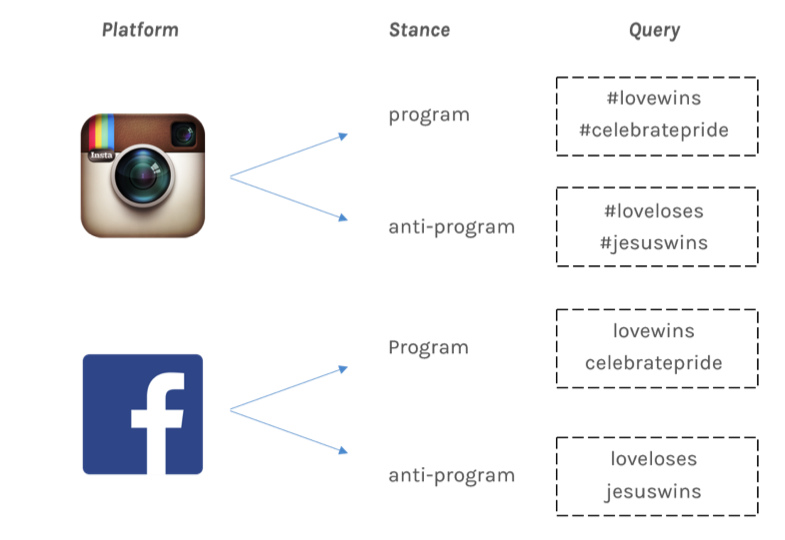
Content Analysis
A combination of network graphs and manual queries was used to perform further qualitative content analysis of individual posts. On Instagram, the top 20 most liked pictures for each query were selected manually for two main reasons: First, not all the entries in the database we scraped included a date (so the date had to be verified by visiting the Instagram website) and hashtags like #jesuswins are used in other contexts as well, so each entry had to be identified as a comment on #lovewins. The qualitative analysis of the top 20 #jesuswins posts that were within our timeframe and commented on #lovewins revealed a new anti-program: #redrevolution, which was queried via the Instagram scraper and the top 20 most liked pictures were selected manually again.Geo-location mapping
For the posts gathered from Instagram that included locational data, these were mapped using longitude and latitude. While this included only a small portion of the entire set (32.08% or 7,263 posts), it was possible to reveal the different regions and locations for both the program and anti-program hashtags, as well as the more religious (#jesuswins) and non-religious (#loveloses) posts within the anti-program.Visual Analysis with ImagePlot
To perform a visual analysis of the image set as a whole we used the ImagePlot tool developed by the Software Studies Initiative. This allowed us to aggregate and arrange thumbnail images in order to find visual patterns. The images collected for the program and anti-program were compared, as each was plotted based on median saturation (intensity of colour) and median hue (RGB value from 0-255).Findings
As a general finding, it was difficult to capture the use and spread of the meme on Facebook with the available Netvizz tools, since we could only view and gather data from specific groups and pages, whereas the way the rainbow profile picture circulated was among friend networks. Therefore, in the data available in our set, the meme and anti-meme didnt cross paths in specific places (not on groups or pages) whereas on Instagram the support and counter-reaction crossed paths as the anti-meme posts often also specifically reference #lovewins.Content Analysis
Investigating the hashtags around the program, we analyzed the top 20 most liked Instagram posts in greater detail. Interestingly the most liked (and also commented) #lovewins photo on Instagram is a kind of reaffirmation of religion: the picture with the hand is saying that gay marriage is not against religion, but that religion is about love first. There were also many posts supporting or celebrating the cause. In some cases people were also defending same-sex marriage against more religious groups.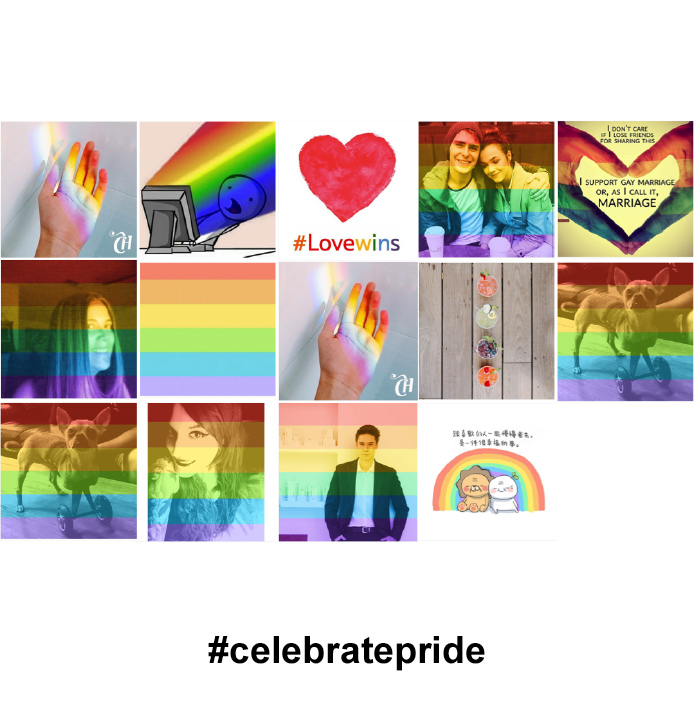 For the anti-program, we divided the negative reactions on Instagram into two categories. First, there were a lot of reactions that are religious in a broad sense: pictures of Bible quotes with the statement that love won when Jesus died, or that Gods law is different from mens law. Interestingly, the majority of these responses would not qualify as memetic since they do not use similar images or use exactly the same quote in different variations. The hashtag #redrevolution was a religious response as well, but here we have clear memetic pattern: an image of a cross on a red background overlaid on individual profile pictures. This can be seen as a direct reaction to the rainbow profile pictures of the #lovewins meme, following the same kind of visual memetic logic.
For the anti-program, we divided the negative reactions on Instagram into two categories. First, there were a lot of reactions that are religious in a broad sense: pictures of Bible quotes with the statement that love won when Jesus died, or that Gods law is different from mens law. Interestingly, the majority of these responses would not qualify as memetic since they do not use similar images or use exactly the same quote in different variations. The hashtag #redrevolution was a religious response as well, but here we have clear memetic pattern: an image of a cross on a red background overlaid on individual profile pictures. This can be seen as a direct reaction to the rainbow profile pictures of the #lovewins meme, following the same kind of visual memetic logic.
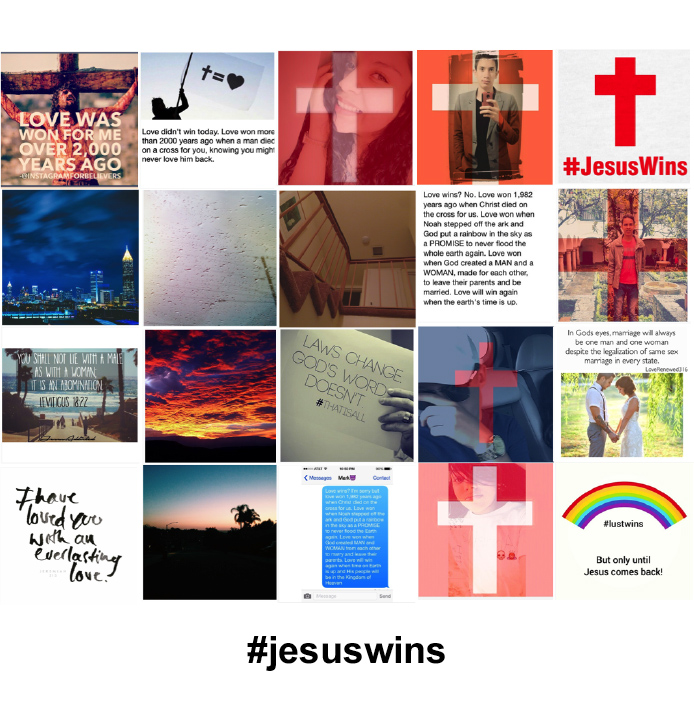
Geo-location mapping
We mapped the #lovewins reaction posts on Instagram, separating posts from each of the days from June 26 to July 1. This shows how the centre of the event is clearly within the United States and the reactions spread out over time to the rest of the world, making this a global political debate.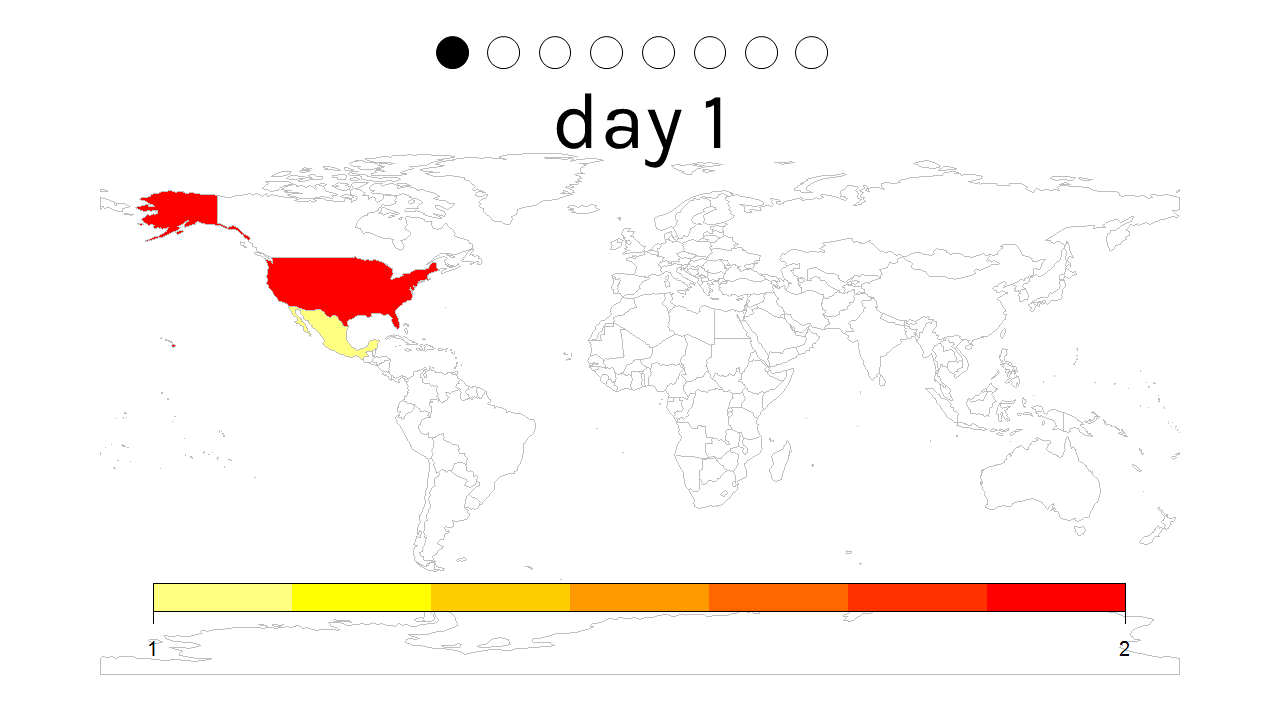 A second mapping also shows the locations of individual posts, separated for the program and anti-program hashtags. The anti-program were further distinguished into the religious and non-religious groupings.
A second mapping also shows the locations of individual posts, separated for the program and anti-program hashtags. The anti-program were further distinguished into the religious and non-religious groupings.
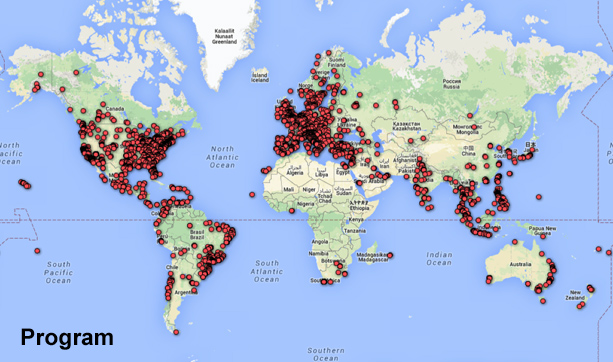
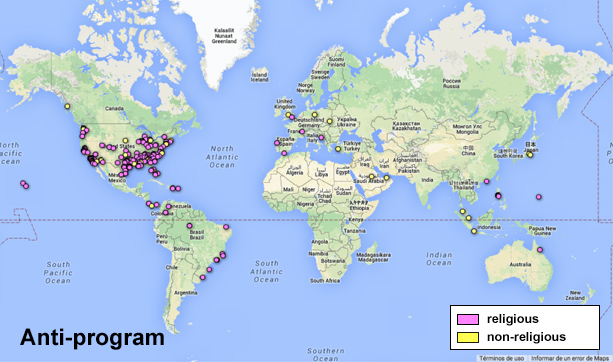
Visual Analysis with ImagePlot
Using Imageplot for a visual analysis also revealed some clear distinctions between the program and anti-program. In particular, the clusters of #redrevolution images were visible in the Imageplot results of the anti-program, supporting or triangulating the results of the more detailed content analysis of the top 20 posts.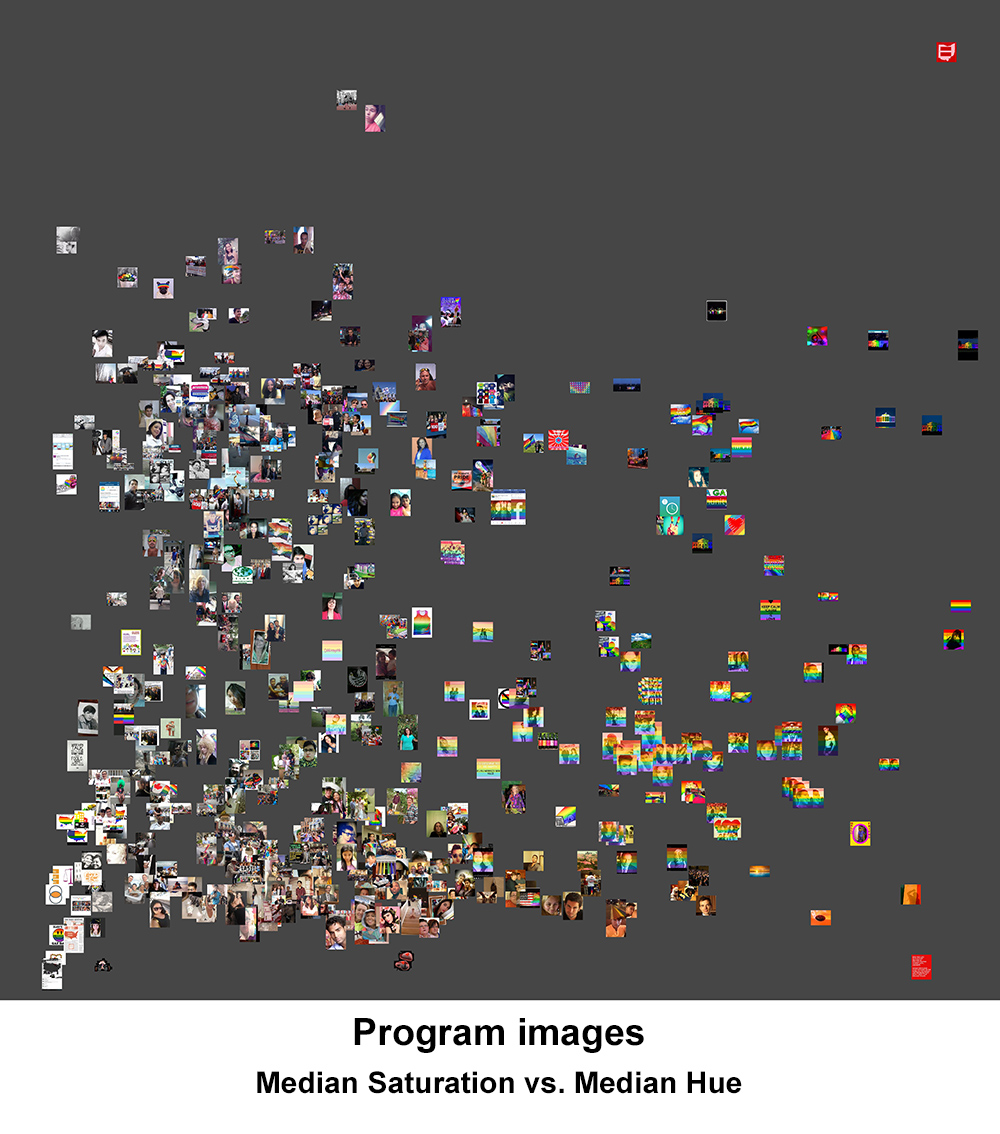
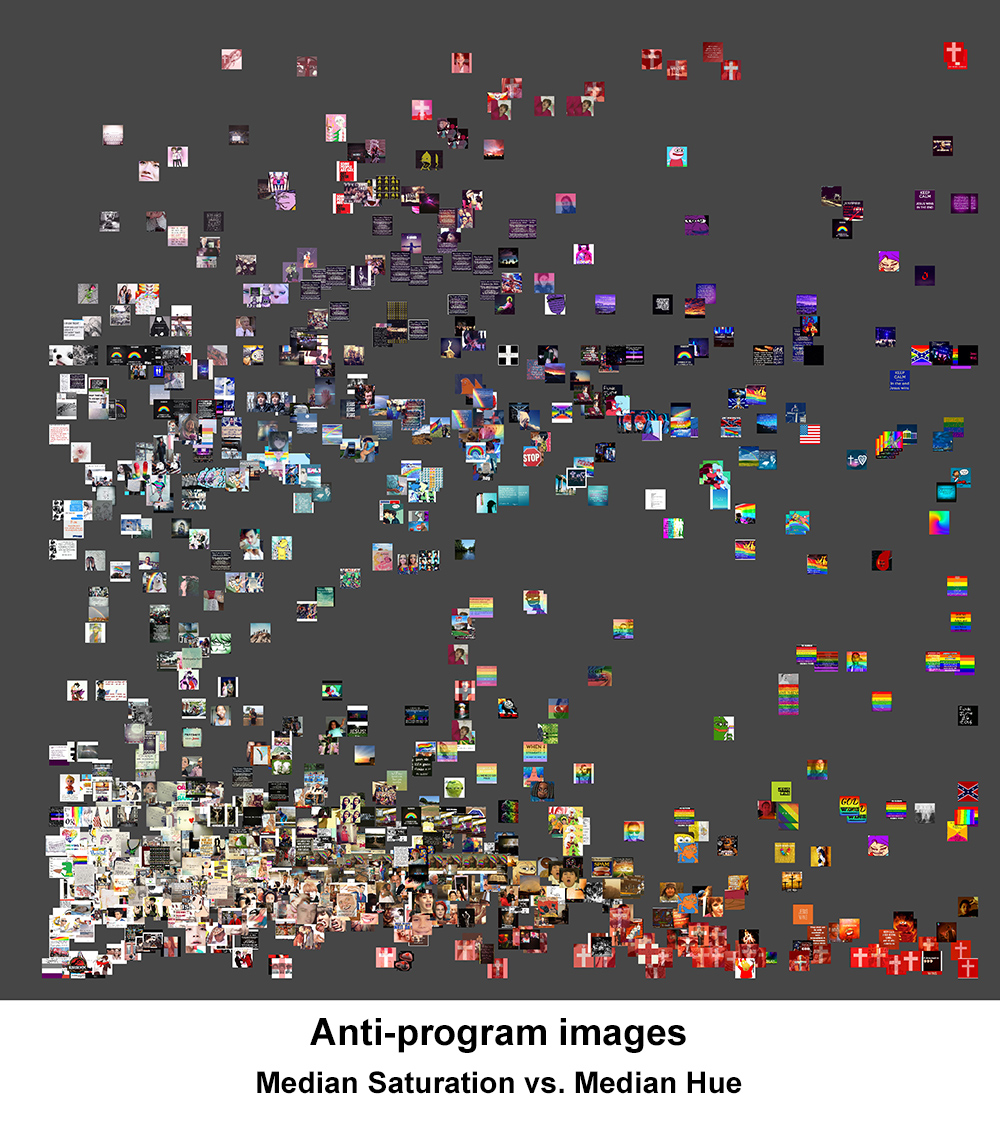
Discussion
The #lovewins case revealed interesting findings regarding the spread and evolution of memes. Memetic reactions start from pre-existing cultural units. This includes the ways that they spread based on existing groupings (friendship networks on Facebook and The visual elements of both #lovewins and #redrevolution reactions drew on existing iconography of rainbows to symbolize pride, and the red cross as a symbol of Christian values of traditional marriage. Medium specific elements constitute the mechanics of memetics. In our case, the different platforms or mediums allow for different expressions of socio-political orientation such as:- Images of the rainbow flag or red cross
- Hashtags of #Lovewins vs #Jesuswins / #RedRevolution
- Comment spaces which further contextualize, and maybe problematize the implied simplicity of the meme
- Geo-location data to trace origins and spread of socio-political orientation
Conclusions
Based on our case study it becomes clear that memes are capable of acting as an expression of socio-political orientation in terms of support and counter-reaction. We can see this particularly in the medium specificities of visuals with regards to the usage of coloured flags in the space of profile pictures and in the usage of hashtags which tie together the dataset as well as the online debate and clearly divide the debate in pro and contra discussants. The comment space can also be used to declare the position, regardless of the depiction of certain imagery or hashtags. In that way it can be used autonomously. The geo-location is interesting as this allows to study the origins of socio-political orientation outside social media in the offline sphere.Bibliography
Shifman, L. (2014). Memes in digital culture. Cambridge, Massachusetts: The MIT Press. -- EmilyMaemura - 12 Jul 2015| I | Attachment | Action | Size | Date | Who | Comment |
|---|---|---|---|---|---|---|
| |
DoesLoveWin-Presentation.pdf | manage | 2 MB | 24 Jul 2015 - 18:30 | Main.emaemura | |
| |
Imageplot-AntiProgram.jpg | manage | 585 K | 24 Jul 2015 - 18:25 | Main.emaemura | |
| |
Imageplot-Program.jpg | manage | 432 K | 24 Jul 2015 - 18:23 | Main.emaemura | |
| |
map-antiprogram.jpg | manage | 153 K | 24 Jul 2015 - 18:09 | Main.emaemura | |
| |
map-program.jpg | manage | 160 K | 24 Jul 2015 - 18:08 | Main.emaemura | |
| |
map-spreadovertime.gif | manage | 172 K | 24 Jul 2015 - 17:04 | Main.emaemura | |
| |
querydesign.png | manage | 112 K | 24 Jul 2015 - 16:55 | Main.emaemura | |
| |
topimages-celebratepride.jpg | manage | 222 K | 24 Jul 2015 - 18:07 | Main.emaemura | |
| |
topimages-jesuswins.jpg | manage | 298 K | 24 Jul 2015 - 18:08 | Main.emaemura |
Edit | Attach | Print version | History: r4 < r3 < r2 < r1 | Backlinks | View wiki text | Edit wiki text | More topic actions
Topic revision: r4 - 28 Aug 2019, JannaJoceliOmena
 Copyright © by the contributing authors. All material on this collaboration platform is the property of the contributing authors.
Copyright © by the contributing authors. All material on this collaboration platform is the property of the contributing authors. Ideas, requests, problems regarding Foswiki? Send feedback


